Color of Night Blu-ray Movie
HomeColor of Night Blu-ray Movie 
Kino Lorber | 1994 | 1 Movie, 2 Cuts | 139 min | Rated R | Aug 21, 2018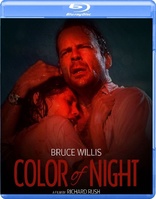
Movie rating
5.7 | / 10 |
Blu-ray rating
| Users | 3.2 | |
| Reviewer | 3.0 | |
| Overall | 3.0 |
Overview
Color of Night (1994)
A psychiatrist is haunted by his failure with a suicidal patient. While on a break from his own practice, he visits a friend and colleague who, soon thereafter, is brutally murdered. Hunting for the killer, he finds himself taking over his colleague's therapy group and simultaneously entering into an intense romance with a mysterious beauty who appears and disappears without explanation.
Starring: Bruce Willis, Jane March, Rubén Blades, Lesley Ann Warren, Brad DourifDirector: Richard Rush
| Erotic | Uncertain |
| Romance | Uncertain |
| Drama | Uncertain |
| Film-Noir | Uncertain |
| Crime | Uncertain |
| Mystery | Uncertain |
| Thriller | Uncertain |
Specifications
Video
Video codec: MPEG-4 AVC
Video resolution: 1080p
Aspect ratio: 1.85:1
Original aspect ratio: 1.85:1
Audio
English: DTS-HD Master Audio 5.1 (48kHz, 16-bit)
English: DTS-HD Master Audio 2.0 (48kHz, 16-bit)
Both cuts
Subtitles
English SDH
Discs
Blu-ray Disc
Two-disc set (2 BDs)
Playback
Region A (locked)
Review
Rating summary
| Movie | 3.0 | |
| Video | 1.5 | |
| Audio | 3.0 | |
| Extras | 3.5 | |
| Overall | 3.0 |
Color of Night Blu-ray Movie Review
Not Seeing Red—and Seeing Double
Reviewed by Michael Reuben September 7, 2018Director Richard Rush's Color of Night was released on Blu-ray by Mill Creek six years ago,
but Kino Lorber is reissuing it in an unexpected format. My review of the Mill Creek disc
described the post-production battle that resulted in two competing versions, one edited by Rush
and the other by producer Andrew Vajna. Vajna's version bombed at the box office and garnered
the 1994 Razzie for Worst Film. But Rush won the right to have his version replace it on video,
where it achieved respectable reviews and has won a loyal following. I'm a fan of the film, but I
would never claim that Color of Night is a masterpiece. It has grand aspirations and major flaws,
and I tried to explore both in my earlier review.
Vajna's cut has been little seen since it crashed and burned in 1994, but Kino is resurrecting it in
a two-disc set containing both cuts, thereby allowing fans to make their own comparison. Adding
to the appeal of this set are some new extras, including two commentaries recorded specially
for this edition. One of them is with Rush, and it's an essential addition to an understanding of
both the film and its troubled history. The other is by co-screenwriter Matthew Chapman, and it
is truly the strangest commentary I have heard since I first started listening to them on laserdisc.
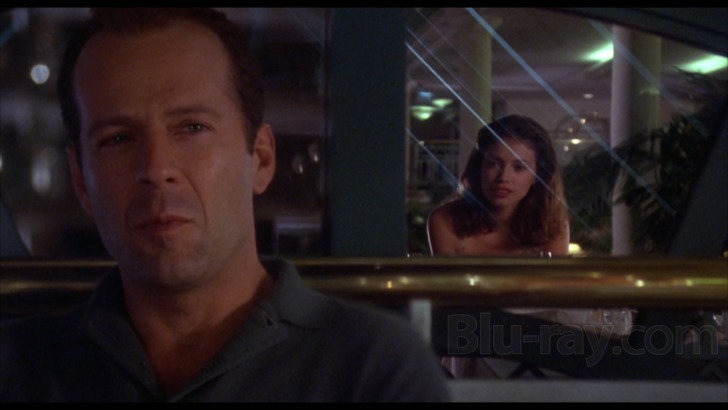
Having now rewatched Color of Night in two versions, I stand by the assessment in my original review. But Andrew Vajna's theatrical cut is a graphic demonstration of the power of editing to make or break a film. (Note that, in the following discussion, I will attempt to avoid spoilers but will assume as least as much familiarity with the film as is reflected in my 2013 discussion.)
If you know Rush's version (and maybe even if you don't), you can tell right away that something is seriously "off" with Vajna's cut. Rush was one of those directors who edited in his head while shooting, and he shaped his shots and scenes to cut together, flow into each other and pull the story forward. Vajna had no feel for Rush's rhythm, and right from the outset, his version feels choppy and uncomfortable, even when it's tracking the same narrative outline.
Let me illustrate with a simple but glaring example. Near the film's end, when Bruce Willis' Dr. Capa regains his ability to see red, he is staring at a bright red light in the rain. In Rush's cut, the light begins as white and then fades to red, followed by a cut to Capa smiling in delighted relief. But Vajna starts on the red light, omitting the transition, and you're supposed to infer that Capa is cured rather than experiencing it from his point of view. It's a clueless omission that destroys what should be the film's emotional climax.
Vajna changes individual shots throughout the film, always for the worse. For example, when Capa and Rose (Jane March) first embrace, they fall into a swimming pool together, where their first love scene occurs. Vajna simply watches them fall, whereas Rush uses a stylized pullback so that the camera views their embrace from a distance through a large porthole window—one of the film's many examples of distorted and circumscribed points of view. It's a visually elegant way to emphasize that Capa has no idea what he's getting into, but Vajna obviously had no interest in such cinematic subtleties
One could go through the two versions scene by scene citing other examples, but now let's turn to some larger alterations. We'll start with the deletions.
- Capa's opening session with his suicidal patient has been cut short. Rush's version provides better insight into her state of mind and a more effective buildup to her sudden plunge out his window. It also supplies the full context of Capa's "keyhole" analogy, which is one of the film's central metaphors.
- Bob Moore's (Scott Bakula) exchange with Capa about how his book made him wealthy has been dropped. Given his palatial spread in the Hollywood Hills, it needs to be there.
- Vajna's cut eliminates an entire subplot that connects Det. Martinez (Rubén Blades) and Buck (Lance Henriksen), the angriest member of the therapy group. Among other things, this subplot explains why Martinez wants to avoid being the one to tell the group that their therapist, Dr. Bob, has been murdered. Vajna leaves that point hanging. The omission also results in the removal of nearly all of Eriq La Salle's scenes as Anderson, Martinez's sergeant.
- The dinner table section has been removed from the initial love scene between Rose and Capa, which both changes the rhythm of the sequence and deprives it of much-needed comic relief.
- When Capa chases Rose's vehicle, he takes great pains to memorize the license plate, but in Vajna's cut nothing ever comes of that effort. In Rush's, Capa has Anderson track down the vehicle's owner, which fills in several plot gaps.
- Just before he is murdered, Bob Moore takes great pains to hide a separate journal he has been keeping about the threat posed by someone in the therapy group. In Rush's cut, when Capa discovers the journal, he actually reads from it, but in Vajna's, he doesn't look at a single word, merely pulls out the revealing insert.
- In Vajna's cut, there is only one scene with Capa's mentor, Ashland (Jeff Corey), which occurs early in the film before Capa leaves New York. Vajna omits the later scene where the two therapists meet again, when Anderson is visiting L.A. for a conference. The scene is crucial for the film's psychological explanation (I can't be more specific without spoilers).
An even more pointless extension occurs after Capa has been attacked by the mysterious red sports car. Spotting it high above him on the roof of the parking structure from which it has just pushed another vehicle over the edge, Capa races up the stairs to intercept it—a meaningless exercise, since the car will be long gone by the time he reaches the top. Rush wisely omitted this footage as the useless filler it is, especially so late in the story.
This list is by no means exhaustive, and I encourage fans of Color of Night (or the merely curious) to check out both versions for themselves. In whatever order you watch them, the superiority of Rush's cut will be immediately obvious.
Color of Night Blu-ray Movie, Video Quality 
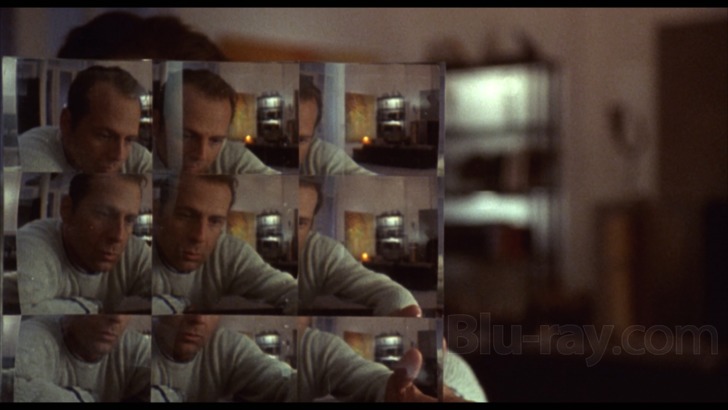
I was underwhelmed by Mill Creek's Blu-ray presentation
of Color of Night, and Kino's pair of
1080p, AVC-encoded discs doesn't significantly improve on that earlier version. Kino has used
the same DVD-vintage transfer of the director's cut (presumably supplied by Disney, which owns
the film), and I give them credit for doing additional cleanup to remove the worst of the dust,
nicks, speckles and splotches that Mill Creek left on the master. But nothing can be done to
improve the dated transfer's undersaturated colors, fuzzy image and weak detail. A new transfer
would be required, and neither Kino nor Disney has done one.
The transfer of the theatrical cut appears to date from the same time period, and it matches the
director's cut, with all of the same limitations. As a side note, one has to wonder why both
versions were transferred, since the producer had already agreed that only the director's cut
would appear on video. But whatever the circumstances, the film has not been newly scanned for
this edition.
In an unfortunate cost-cutting move, Kino has authored both the 139-minute director's cut and
the 123-minute theatrical cut on separate BD-25s, resulting in average bitrates of 17.67 and 20.07
Mbps, respectively. Noticeable artifacts have been avoided, but one has to wonder whether these
dated transfers might look at least a little better with more generous encoding. (Mill Creek
stuffed the director's cut onto a two-movie single disc with an average bitrate of 19.00 Mbps.)
Any feature that runs more than ninety minutes deserves a BD-50, without exception.
My original video score for Mill Creek's edition was 1.5, and I'm keeping it for Kino's edition.
Arguably the score should be lower, because there's no excuse in this era for recycling antique
transfers, but Kino deserves some credit for the additional cleanup.
In the accompanying screenshots, the first thirteen are from the director's cut. Shots from the
theatrical cut follow the director's cut menu screen.
Color of Night Blu-ray Movie, Audio Quality 
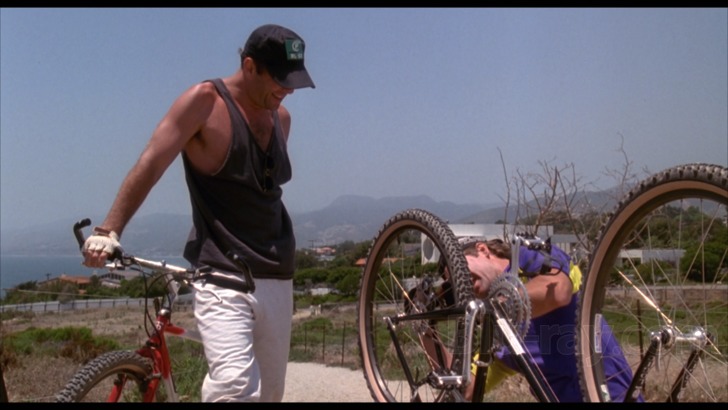
In my review of Mill Creek's disc, I noted that
Color of
Night's theatrical cut may have had a 5.1
soundtrack but that the director's cut has only ever had 2.0. Well, Kino has provided both 5.1 and
2.0 mixes for both, with all of them encoded in lossless DTS-HD MA. I suspect that the
theatrical cut's 5.1 track is from the original release, while the director's cut is a remix based on
the stereo surround track from previous versions. In either case, there isn't a significant
difference between the two tracks. The discrete channel format makes the dialogue a little tighter
and clearer and provides a little more breathing room for Dominic Frontiere's score, but the mix
remains forward-oriented and never fully expands into the surrounds. Bass extension is still fairly
limited, but the highs are effectively rendered (the shattering glass that accompanies several of
the film's deaths is a good example).
It struck me in listening to the two cuts that the mixes vary in what elements are emphasized. In
particular, Frontiere's score is more dominant during the therapy sessions in the theatrical
version, which creates a jarring effect, because those cues are some of the film's most comical.
(They're reminiscent of The Stunt Man's light-
hearted
tone, also a Frontiere score.) In the
director's cut, the score provides a subtle undercurrent to the often extreme behavior of the
patients in therapy, but in the theatrical cut the music almost seems to be mocking them.
Color of Night Blu-ray Movie, Special Features and Extras 
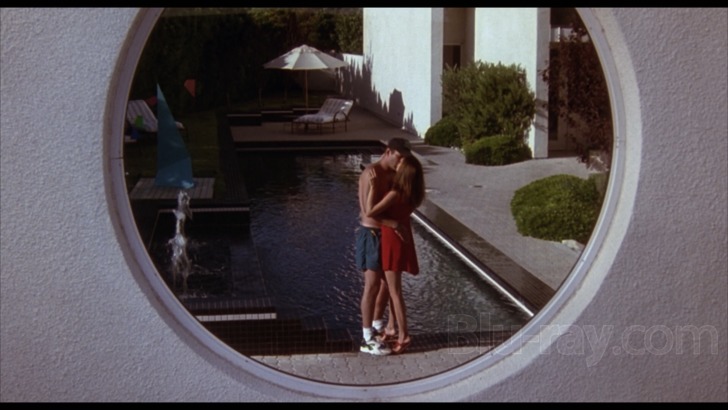
- Commentary with Director Richard Rush Moderated by Filmmaker Elijah Drenner (Director's Cut): Rush is nearly 90, but his energy is strong, his focus is sharp and his memory is detailed (with the occasional inability to recall a name). He opens the commentary with a lengthy account, which he wrote out on paper the night before recording, of the fight over the release version between him and producer Andrew Vajna. The rest of the commentary deals with casting (notably Rush's complicated relationship with Willis), visual style, the movie's themes and a variety of technical matters. Rush also discusses his approach to directing and describes other projects he has attempted to develop, as well as many he turned down that became major successes for other directors. Drenner is an effective moderator, prompting Rush with questions and engaging him in dialogue. For any fan of either Rush or Color of Night (or both), this is essential material.
- Trailers (Director's Cut)
- Color of Night
- The Rich Man's Wife
- The Tie That Binds
- Deceived
- Commentary with Screenwriter Matthew Chapman Moderated by
Filmmaker Heather Buckley (Theatrical Cut): As I said in the introduction, this
is the strangest commentary I have yet to encounter. Chapman was an
intermediate screenwriter, reworking an original draft by screenwriter Billy Ray,
which was then substantially rewritten by the director (uncredited). His role
during production seems to have been limited to responding to a request for input
from producer Andrew Vajna when the latter was looking for ammunition to use
against Rush. Chapman doesn't much like the film and hasn't seen it for years,
and most of his comments have nothing to do with Color of Night, focusing instead
on his own biography, his other work and his aesthetic preferences in filmmaking.
Buckley's experience is primarily as a producer, and she's a terrible moderator. At one point, she admits that she's talking too much about herself, including naming multiple films she prefers to Color of Night and directors she prefers to Rush. She and Chapman also exchange film recommendations. (He tells her to see Blue Is the Warmest Color for its sex scenes, and she recommends The Ninth Configuration, because, like Color of Night, it involves psychiatry.)
Late in the commentary, both participants let something slip that confirms how unqualified they are for the task. They ask each other which cut of the film they're watching, and neither one knows. Then they both express approval that Kino is releasing the director's cut of Color of Night, apparently unaware that it's been available on video for 23 years and what they're watching is the "new" version. How informative this commentary might have been with people who actually know Color of Night well enough to talk about the film instead of themselves. - Animated Image Gallery (Theatrical Cut) (1080p; various; 2:11): The images include production stills, behind-the-scene shots and the theatrical one-sheet.
Color of Night Blu-ray Movie, Overall Score and Recommendation 
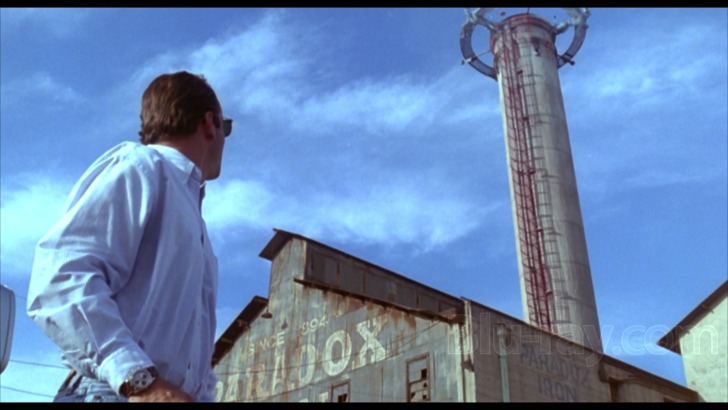
One has to give Kino their due. They've performed a service for Color of Night's fans by
exhuming the failed theatrical cut so that one can experience just how bad it is and why it fizzled
in theaters. And the new commentary by Rush is a gold mine of information and insight. On the
downside, however, the film's video presentation remains inferior, and its audio is merely
adequate. As for the second commentary, it's as bad as the theatrical cut it accompanies, and
possibly worse. Maybe that's poetic justice. Recommended, with appropriate caveats, for fans of
Rush's work in general and devotees of Color of Night in particular, especially since Mill
Creek's disc is now out of print.
Similar titles
Similar titles you might also like

Killing Me Softly
2002

9 Songs
2004

Original Sin
2001

Sex and Lucía
Lucía y el sexo | Unrated Director's Cut
2001

The Brown Bunny
Limited to 250 sets / Signed & Numbered
2004

The Loft
2014

Basic Instinct
Unrated Director's Cut
1992

Cruising 4K
Limited Edition
1980

Body of Evidence
1993

Basic Instinct 2
Collector's Edition
2006

Body Heat
1981

Wild Things: Foursome
Unrated Edition
2010

The Crimson Kimono
Limited Edition to 3000
1959

Bad Timing
Bad Timing: A Sensual Obsession
1980

Sliver 4K
Slipcover in Original Pressing
1993

Jennifer 8
Special Edition
1992

Whispers in the Dark
1992

Whirlpool
Limited Edition to 3000
1950

Blue Velvet 4K
1986

Dead Again
1991
